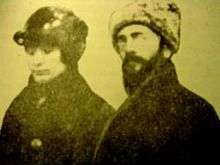Fanya Baron
| Fanya Baron | |
|---|---|
 Fanya Baron in pre-revolutionary Russia | |
| Born |
Freida Nisanovna Greck 1887 |
| Died |
September 29, 1921 Moscow |
| Cause of death | Executed |
| Religion | Jewish |
| Spouse(s) | Aron Baron |
| Children | Theodore Baron |
| Parent(s) | Nathan Grefenson and Chasse Plutzky |
Fanya Anisimovna Baron (Russian: Фа́ня Ани́симовна Ба́рон) (1887 – September 29, 1921) was a Russian anarchist revolutionary who lived in America from 1911[1] to 1917[2] when she returned to her homeland to build a post-revolutionary society. In 1921, she was executed by the Cheka.
A life lived in thirty-six months
Nabat and the Makhno movement
Fanya was involved in the Nabat Ukrainian Anarchist Confederation (active 1919-1920) who published a paper also called Nabat ("The Alarm"). The Nabat confederation had ties with the Makhno movement. Several Nabat members (among them Fanya's husband Aron Baron, Voline and Peter Arshinov) were active in the Cultural-Educational Section of the Makhno movement.

Voline and Aaron Baron were among anarchists who were arrested in a Cheka crackdown on anarchism at the end of 1920 (Avrich, 1973). It is likely that Fanya Baron was also arrested at this time.
Escape from prison
In early July 1921, Fanya escaped from Ryazan prison. She planned to help her husband Aron Baron escape from prison in Moscow. Aaron's brother, Semion, a Bolshevik communist, offered to help with the plan. Later the same year, they were found out, with Fanya being arrested by the Cheka, and Semion Baron being executed on the spot. [3]
Capture and execution
Fanya Baron was among 13 anarchists held at Taganka prison without charges. In July 1921, they went on hunger strike, attracting the attention of visiting French, Spanish and Russian syndicalists who argued for their release. Leon Trotsky remarked at the time "We do not imprison the real anarchists, but criminals and bandits who cover themselves by claiming to be anarchists".[4]
Ten of the 13 anarchists were released and deported on 17 September 1921: Voline, Vorobiov, Mratchny, Michailov, Maximoff, Ioudine, Iartchouk, Gorelik, Feldman and Fedorov. Fanya Baron and the poet Lev Chernyi were detained, to be executed later that month. Her execution was personally ordered by Lenin himself.
Fanya was shot by the Cheka on 29 September 1921. Aron Baron was spared execution[5] until 1937, after spending 17 years in numerous prisons and exiles.
Eulogy
Emma Goldman wrote about the execution of Fanya Baron in My Further Disillusionment in Russia:
Fanya Baron was of the type of Russian woman completely consecrated to the cause of humanity. While in America she gave all her spare time and a goodly part of her meagre earnings in a factory to further Anarchist propaganda. Years afterward, when I met her in Kharkov, her zeal and devotion had become intensified by the persecution she and her comrades had endured since their return to Russia. She possessed unbounded courage and a generous spirit. She could perform the most difficult task and deprive herself of the last piece of bread with grace and utter selflessness. Under harrowing conditions of travel, Fanya went up and down the Ukraina to spread the Nabat, organize the workers and peasants, or bring help and succour to her imprisoned comrades. She was one of the victims of the Butyrki raid, when she had been dragged by her hair and badly beaten. After her escape from the Ryazan prison she tramped on foot to Moscow, where she arrived in tatters and penniless. It was her desperate condition which drove her to seek shelter with her husband's brother, at whose house she was discovered by the Tcheka. This big-hearted woman, who had served the Social Revolution all her life, was done to, death by the people who pretended to be the advance guard of revolution. Not content with the crime of killing Fanya Baron, the Soviet Government put the stigma of banditism on the memory of their dead victim.
Fanya Baron in contemporary culture
An Australian anarchist bookshop, Jura Books, has named their library collection The Fanya Baron Library in honour of her courage and sacrifice for anarchist revolution.[6] Fanya is also mentioned in the 1939 Kenneth Rexroth poem, titled "August 22, 1939".
See also
- Peter Arshinov
- Alexander Berkman
- Emma Goldman
- Nestor Makhno
- Okhrana
- Russian Revolution of 1917
- Russian Civil War
References
- ↑ "Radical Women: The Haymarket Tradition - By Carolyn Ashbaugh". Web.archive.org. 2012-02-04. Archived from the original on 2012-02-04. Retrieved 2016-03-29.
- ↑ "chile1 «". Zabalaza.net. 2010-12-08. Retrieved 2016-03-29.
- ↑ "Living My Life: Chapter 52". Dwardmac.pitzer.edu. Retrieved 2016-03-29.
- ↑ Voline, 1947
- ↑ Goldman, Emma. "Chapter 52, Continued, pp. 899-927.". Living My Life. Anarchy Archives. Retrieved 2008-11-21.
- ↑ "Jura Library | Jura Books". Jura.org.au. Retrieved 2016-03-29.
Sources
- Avrich, Paul (Editor), 1973, The Anarchists in the Russian Revolution
- Berkman, Alexander, 1922, The Bolshevik Myth
- Goldman, Emma My Further Dissillusionment in Russia
- Goldman, Emma Living my Life (Volume 2)
- Serge, Victor, July, August 1920, The Anarchists and the Experience of the Russian Revolution
- Voline, The Unknown Revolution, Black Rose Books 1974 (originally published 1947)
- Woodcock, George, 1944, Socialism from Below: A History of Anarchism